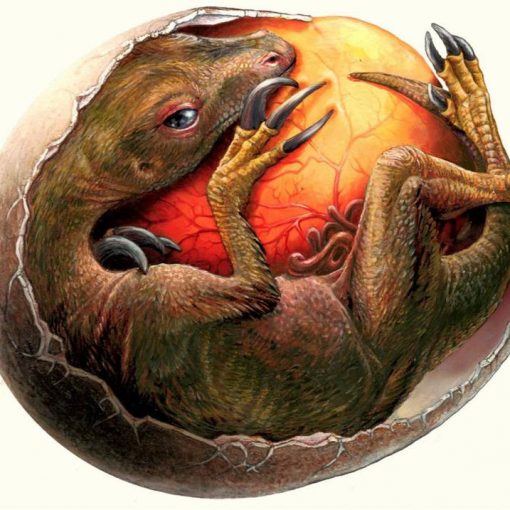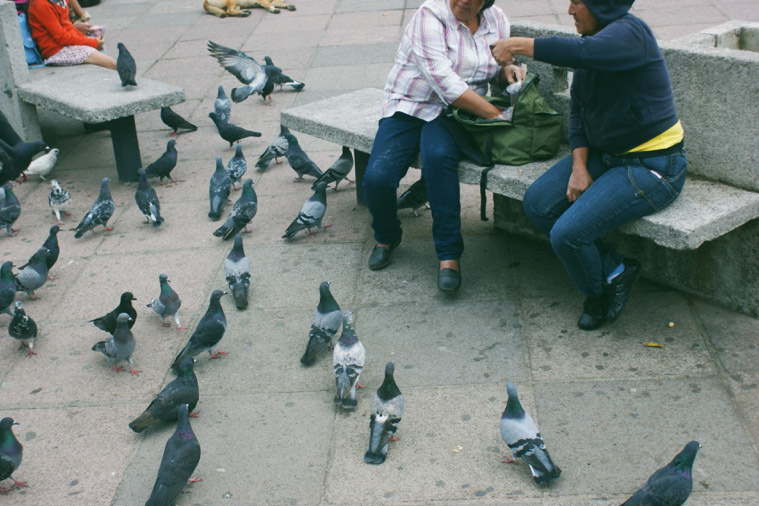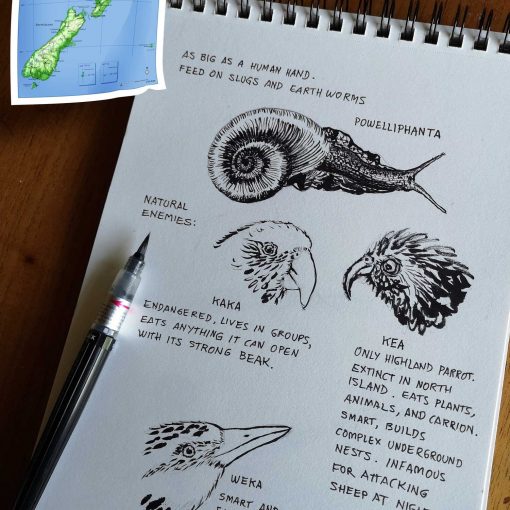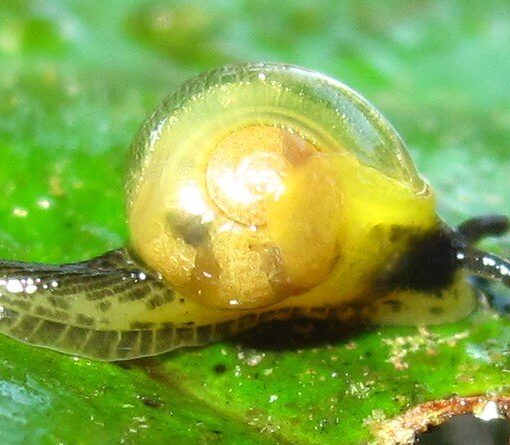Author: Julián Monge Nájera, Ecologist and Photographer
Some snails appear mysteriously in temporary ponds so small that they would not be enough to fill a large pot. How do they get there? Do all of them die when the pond dries up? And, in that case, how does the species survive?

In order to understand the life of the pond snails that appear mysteriously all over the world, even in rain pools, I chose Aplexa hypnorum as an example, a typical snail of that group for which there is a nice study, done by malacologists Cornelis den Hartog and L. de Wolf, from the Netherlands Hydrological Institute, in a small irrigation canal conveniently located only 50 m away from their office ¹.
Their study is more or less as old as I am: they started it when my mother was 7 months pregnant. The name hypnorum (sleeper) refers to the ability of surviving inactive in very dry or very cold periods.
Impressively, sometimes this water snail lives in large numbers in ponds just a couple of centimeters deep, as seen in the vicinity of Doorwerth Castle².

In my sketchbook: ecology of a typical pond snail, Aplexa hypnorum, whose natural history has been especially studied in the Netherlands, where it is abundant around Doorwerth Castle.
These snails are found in all kinds of ponds, from cultivated open areas to swampy areas next to lakes and forests. Stagnant water is their home, as long as the acidity ranges from pH 5 to 9.
The biography of this snail, called in English “moss bladder snail”, begins with an egg; a few days before the pond dries, the snails migrate to the bottom and attach their eggs to vegetation, pieces of wood and even stones, just in the level that will retain moisture the longest. The eggs, each 1mm long, are kept moist and protected in a gelatinous bag with up to 25 eggs, and hatch 2 weeks later³.
How long do they need to mature? According to some authors, 2 months; according to others, 2 years. We don’t know if these very different values are errors or if there really is so much variability from one place to another. In any case, it is suspected that some of these snails live up to 4 years, but in this there is also a lot of room to investigate³.
In addition to drought, there is another hard period for Aplexa hypnorum: when winter starts, ponds freeze and both eggs and some snails of various ages enter a period of inactivity, their breathing is reduced to the minimum needed to maintain vital functions. Many do not survive, especially the older ones, but those who do survive awaken with spring in late March. In some cases, a second generation is born in October, joining the spring generation, and possibly in other places, reproduction occurs at other times of the year³.
After drought or cold, the key for the snails is to eat well to grow as quickly as possible. Ponds have two sources of food, what falls from the surrounding land, such as leaves and branches; and the vegetation and aquatic organisms typical of the pond. Snails eat all kinds of decomposing plant and animal matter, including carrion. They are often low in nutrients, which explains why they eat almost constantly. This aspect, to my knowledge, has not been noticed by those who have studied them, but it must have a marked effect on the evolution of this snail, which is often seen floating upside down and feeding on the invisible plankton that floats on the water. Occasionally, the snails seems to be outside the water, thanks to a little trick: when the snail scrapes algae from emerged vegetation, it stays inside an almost invisible blanket of water that prevents desiccation³.
Aplexa hypnorum is the water snail that lives closest to the polar circle (74 degrees north latitude), and survives 13 degrees Celsius below zero⁴. It is not yet known how it reaches the most remote ponds, but it is believed that eggs and young can be transported by birds, insects, mammals and floods.
Compared to other snails, Aplexa hypnorum is a detritivore of organic-rich temporary ponds, in which it has an advantage over species that need cleaner or more durable waters⁵; it produces a mucus that is toxic to limnaeid snails such as Galba truncatula and Omphiscola glabra, which, not surprisingly, are its direct competitors: they live in the same places and feed on the same resources⁵.
The snail also has tiny enemies, it is host to the single-cell parasite Pfeifferinella ellipsoides, which apparently does little harm⁶, and for millions of years, it has waged a war against the larvae of the so-called «snail-killing flies» such as Atrichomelina pubera⁷ and Platygymnopa helicis⁸.
Fossils indicate that Aplexa hypnorum lived in much of Europe during the Pleistocene, a million years ago, but the modification that the European landscape has undergone in recent decades has been taking away its habitats: today it is extinct in Sweden, and has become rare in the rest of the continent (it is still debated whether it also occurs in North America). Perhaps for humans this snail is useless, although it must have an arsenal of powerful substances to avoid infections in the stagnant waters where it lives. But its spectacular ability to live in ponds a few centimeters deep, ponds that dry and freeze annually, deserves our respect and admiration.
*Edited by Zaidett Barrientos, Katherine Bonilla y Carolina Seas.
Originally published in Blog Biología Tropical: 19 august 2020
REFERENCES
¹ Den Hartog, C., & De Wolf, L. (1962). The life cycle of the water snail Aplexa hypnorum. Basteria, 26(5/6), 61-72.
² Bremekamp, N. N. (1950). Aplexa Hypnorum (L.) van de Rijnuiterwaarden. Correspondentieblad NMV, 37(1), 313-314.
³ Den Hartog, C. (1963). The distribution of the snail Aplexa hypnorum in Zuid-Beveland in relation to soil and salinity. Basteria, 27(1/2), 8-17.
⁴ Gold, A. (1975). A study on the ecology of Aplexa hypnorum. Internal report, Biological Station, University of Michigan. Retrieved from https://deepblue.lib.umich.edu/handle/2027.42/52902?show=full
⁵ Brown, K. M. (1982). Resource overlap and competition in pond snails: an experimental analysis. Ecology, 63(2), 412-422.
⁶ Fritsche, T. R. (1987). Studies on the Coccidian Parasites (Apicomplexa: Eimeriidae and Pfeifferinellidae) of Pulmonate Gastropods 1. The Journal of protozoology, 34(1), 75-78.
⁷ Foote, B. A., et al. (1960). Biology and immature stages of Atrichomelina pubera (Diptera: Sciomyzidae). Annals of the Entomological Society of America, 53(2), 192-199.
⁸ Wirth, W. W. (1971). Platygymnopa, a new genus of Ephydridae reared from decaying snails in North America (Diptera). The Canadian Entomologist, 103(2), 266-270.





298 ideas sobre “The biography of a pond snail”
Thanks for sharing, this is a fantastic post.Thanks Again. Fantastic.
purple pharmacy mexico price list: Mexican Easy Pharm – buying prescription drugs in mexico online
buying from online mexican pharmacy https://mexicaneasypharm.com/# Mexican Easy Pharm
mexico pharmacies prescription drugs
http://kamapharm.com/# Kama Pharm
prednisone over the counter australia
http://cytpharm.com/# buy cytotec online
buy prednisone online fast shipping
http://semapharm24.com/# SemaPharm24
prednisone 40 mg
https://semapharm24.com/# buy rybelsus online
prednisone price south africa
https://dappharm.com/# buy priligy
canadian online pharmacy prednisone
https://predpharm.shop/# Pred Pharm
prednisone cream
https://semapharm24.shop/# Sema Pharm 24
generic prednisone online
https://predpharm.shop/# PredPharm
2.5 mg prednisone daily
https://predpharm.com/# PredPharm
generic prednisone otc
https://semapharm24.com/# SemaPharm24
prednisone 25mg from canada
https://dappharm.com/# buy priligy
prednisone 50 mg for sale
https://semapharm24.shop/# Sema Pharm 24
prednisone uk
http://cytpharm.com/# buy cytotec online
prednisone 20mg online without prescription
http://farmasilditaly.com/# siti sicuri per comprare viagra online
acquisto farmaci con ricetta
https://farmabrufen.com/# BRUFEN 600 acquisto online
farmacie online autorizzate elenco
http://farmasilditaly.com/# viagra online consegna rapida
farmacia online piГ№ conveniente
https://farmaprodotti.com/# Farmacie online sicure
migliori farmacie online 2024
http://taya777.icu/# Security measures ensure a safe environment.
Slot machines attract players with big jackpots.
https://winchile.pro/# Las ganancias son una gran motivaciГіn.
Some casinos feature themed gaming areas.
http://taya365.art/# Some casinos feature themed gaming areas.
Gambling can be a social activity here.
https://taya777.icu/# Casinos often host special holiday promotions.
Resorts provide both gaming and relaxation options.
https://winchile.pro/# La diversiГіn nunca se detiene en los casinos.
The casino scene is constantly evolving.
http://taya365.art/# Cashless gaming options are becoming popular.
Poker rooms host exciting tournaments regularly.
http://phtaya.tech/# Gaming regulations are overseen by PAGCOR.
Many casinos have beautiful ocean views.
https://phtaya.tech/# Many casinos host charity events and fundraisers.
The casino scene is constantly evolving.
http://taya777.icu/# Players must be at least 21 years old.
Players enjoy a variety of table games.
http://jugabet.xyz/# Algunos casinos tienen programas de recompensas.
Gaming regulations are overseen by PAGCOR.
http://winchile.pro/# Las promociones de fin de semana son populares.
Poker rooms host exciting tournaments regularly.
https://phmacao.life/# Poker rooms host exciting tournaments regularly.
Some casinos have luxurious spa facilities.
https://phtaya.tech/# The Philippines has a vibrant nightlife scene.
The casino industry supports local economies significantly.
http://phtaya.tech/# The poker community is very active here.
Many casinos offer luxurious amenities and services.
http://phmacao.life/# п»їCasinos in the Philippines are highly popular.
Cashless gaming options are becoming popular.
http://phmacao.life/# Most casinos offer convenient transportation options.
Many casinos host charity events and fundraisers.
http://phmacao.life/# High rollers receive exclusive treatment and bonuses.
Security measures ensure a safe environment.
http://winchile.pro/# Es comГєn ver jugadores sociales en mesas.
Most casinos offer convenient transportation options.
https://winchile.pro/# Las promociones de fin de semana son populares.
Responsible gaming initiatives are promoted actively.
https://jugabet.xyz/# Los casinos organizan noches de trivia divertidas.
Security measures ensure a safe environment.
https://jugabet.xyz/# La competencia entre casinos beneficia a los jugadores.
Slot machines feature various exciting themes.
https://winchile.pro/# Las promociones de fin de semana son populares.
Many casinos provide shuttle services for guests.
http://jugabet.xyz/# La Г©tica del juego es esencial.
The gaming floors are always bustling with excitement.
no prescription pharmacy paypal http://discountdrugmart.pro/# no prescription pharmacy paypal
rx pharmacy coupons https://megaindiapharm.com/# Mega India Pharm
canadian pharmacy discount code https://megaindiapharm.shop/# MegaIndiaPharm
pharmacy coupons http://familypharmacy.company/# Cheapest online pharmacy
best online pharmacy no prescription https://familypharmacy.company/# Online pharmacy USA
best online pharmacy no prescription https://xxlmexicanpharm.com/# mexican border pharmacies shipping to usa
online canadian pharmacy coupon https://megaindiapharm.com/# Mega India Pharm
foreign pharmacy no prescription https://megaindiapharm.shop/# india pharmacy mail order
canadian pharmacy no prescription needed https://easycanadianpharm.shop/# best canadian pharmacy to order from
canadian pharmacy discount coupon https://xxlmexicanpharm.shop/# reputable mexican pharmacies online
best canadian pharmacy no prescription https://easycanadianpharm.com/# easy canadian pharm
prescription drugs from canada https://easycanadianpharm.com/# my canadian pharmacy
foreign pharmacy no prescription https://familypharmacy.company/# family pharmacy
canadian pharmacy no prescription needed https://xxlmexicanpharm.shop/# mexican border pharmacies shipping to usa
cheapest pharmacy for prescriptions without insurance https://familypharmacy.company/# Best online pharmacy
overseas pharmacy no prescription http://megaindiapharm.com/# india online pharmacy
pharmacy no prescription required https://familypharmacy.company/# family pharmacy
online pharmacy no prescription http://xxlmexicanpharm.com/# buying prescription drugs in mexico online
legit non prescription pharmacies https://familypharmacy.company/# Best online pharmacy
pharmacy discount coupons https://xxlmexicanpharm.com/# xxl mexican pharm
online pharmacy no prescription https://familypharmacy.company/# Cheapest online pharmacy
canada drugs coupon code https://familypharmacy.company/# family pharmacy
cheapest pharmacy for prescription drugs https://xxlmexicanpharm.shop/# xxl mexican pharm
Kasino mendukung permainan bertanggung jawab https://garuda888.top/# Banyak kasino menawarkan permainan langsung yang seru
Kasino di Jakarta memiliki berbagai pilihan permainan http://garuda888.top/# Kasino mendukung permainan bertanggung jawab
Kasino menyediakan layanan pelanggan yang baik https://slotdemo.auction/# Kasino di Bali menarik banyak pengunjung
Slot menjadi bagian penting dari industri kasino https://slotdemo.auction/# Bermain slot bisa menjadi pengalaman sosial
Slot dengan bonus putaran gratis sangat populer https://slotdemo.auction/# Mesin slot sering diperbarui dengan game baru
Mesin slot baru selalu menarik minat https://preman69.tech/# Jackpot progresif menarik banyak pemain
Mesin slot baru selalu menarik minat http://garuda888.top/# Slot menawarkan kesenangan yang mudah diakses
п»їKasino di Indonesia sangat populer di kalangan wisatawan https://bonaslot.site/# Pemain bisa menikmati slot dari kenyamanan rumah
Slot memberikan kesempatan untuk menang besar https://slotdemo.auction/# п»їKasino di Indonesia sangat populer di kalangan wisatawan
Slot klasik tetap menjadi favorit banyak orang http://garuda888.top/# Slot dengan bonus putaran gratis sangat populer
Mesin slot menawarkan berbagai tema menarik http://preman69.tech/# Slot menjadi daya tarik utama di kasino
Banyak kasino menawarkan permainan langsung yang seru https://slot88.company/# Mesin slot dapat dimainkan dalam berbagai bahasa
Pemain harus memahami aturan masing-masing mesin http://bonaslot.site/# Permainan slot bisa dimainkan dengan berbagai taruhan
Banyak pemain menikmati bermain slot secara online https://preman69.tech/# Pemain sering mencoba berbagai jenis slot
Slot modern memiliki grafik yang mengesankan https://slot88.company/# Banyak pemain menikmati jackpot harian di slot
Banyak pemain menikmati jackpot harian di slot http://slotdemo.auction/# Pemain bisa menikmati slot dari kenyamanan rumah
Permainan slot mudah dipahami dan menyenangkan http://slot88.company/# Slot dengan bonus putaran gratis sangat populer
Jackpot besar bisa mengubah hidup seseorang http://slot88.company/# Pemain sering berbagi tips untuk menang
cost of amoxicillin: Amo Health Pharm – amoxicillin 500 mg tablets
amoxicillin 875 mg tablet: Amo Health Pharm – amoxicillin 500mg
over the counter amoxicillin canada: AmoHealthPharm – amoxicillin 250 mg capsule
cost clomid without insurance: ClmHealthPharm – can you buy generic clomid without a prescription
zithromax for sale 500 mg: ZithroPharm – zithromax 600 mg tablets
zithromax 500mg price: buy zithromax online cheap – order zithromax without prescription
doxycycline 75 mg tab: medication doxycycline 100mg – doxycycline prescription cost
doxycycline over the counter uk: can you buy doxycycline over the counter – doxycycline 100 mg cap over the counter
where to buy amoxicillin 500mg without prescription: Amo Health Pharm – amoxicillin over the counter in canada
buying clomid without dr prescription: ClmHealthPharm – can you buy generic clomid for sale
doxycycline uk: buy doxycycline from canada – buying doxycycline online in usa
can you get generic clomid pills: where to buy clomid no prescription – cost cheap clomid online
can you buy zithromax over the counter in australia: ZithroPharm – zithromax 250mg
purchase amoxicillin online without prescription: how much is amoxicillin – amoxicillin 775 mg
amoxicillin 500 mg price: Amo Health Pharm – cost of amoxicillin prescription
pharmacie en ligne sans ordonnance: pharmacie en ligne sans ordonnance – pharmacie en ligne pas cher
Pharmacie Internationale en ligne: Pharmacie Internationale en ligne – Pharmacie sans ordonnance
п»їpharmacie en ligne france: pharmacie en ligne pas cher – pharmacie en ligne sans ordonnance
Pharmacie en ligne livraison Europe: Acheter Cialis – pharmacie en ligne fiable
pharmacie en ligne pas cher: Acheter Cialis – pharmacie en ligne
acheter mГ©dicament en ligne sans ordonnance: kamagra oral jelly – acheter mГ©dicament en ligne sans ordonnance
pharmacie en ligne fiable: cialis generique – п»їpharmacie en ligne france
pharmacie en ligne fiable: kamagra oral jelly – Pharmacie Internationale en ligne
Pharmacie sans ordonnance: cialis generique – pharmacie en ligne
SildГ©nafil 100 mg sans ordonnance: Acheter Viagra Cialis sans ordonnance – Viagra vente libre pays
trouver un mГ©dicament en pharmacie: pharmacie en ligne sans ordonnance – Pharmacie sans ordonnance
Pharmacie Internationale en ligne: п»їpharmacie en ligne france – vente de mГ©dicament en ligne
Viagra pas cher livraison rapide france: Viagra sans ordonnance 24h – Viagra gГ©nГ©rique pas cher livraison rapide
Pharmacie Internationale en ligne: pharmacie en ligne france livraison internationale – pharmacie en ligne france fiable
п»їViagra sans ordonnance 24h: Viagra homme prix en pharmacie – Viagra homme prix en pharmacie sans ordonnance
pharmacie en ligne france fiable: acheter kamagra site fiable – pharmacie en ligne avec ordonnance
pharmacie en ligne france pas cher: cialis generique – acheter mГ©dicament en ligne sans ordonnance
Pharmacie Internationale en ligne: cialis prix – Pharmacie Internationale en ligne
Acheter Sildenafil 100mg sans ordonnance: Viagra gГ©nГ©rique pas cher livraison rapide – Viagra sans ordonnance livraison 48h
Viagra femme sans ordonnance 24h: Acheter Viagra Cialis sans ordonnance – Viagra femme sans ordonnance 24h
Pharmacie Internationale en ligne: kamagra livraison 24h – pharmacie en ligne livraison europe
п»їpharmacie en ligne france: Acheter Cialis – Achat mГ©dicament en ligne fiable
Pharmacie Internationale en ligne: Tadalafil sans ordonnance en ligne – Pharmacie sans ordonnance
trouver un mГ©dicament en pharmacie: Tadalafil sans ordonnance en ligne – pharmacie en ligne france pas cher
trouver un mГ©dicament en pharmacie: pharmacies en ligne certifiГ©es – Achat mГ©dicament en ligne fiable
Plinko casino game: Plinko game – Plinko
Plinko Deutsch: PlinkoDeutsch – plinko casino
plinko casino: plinko casino – plinko nl
plinko fr: plinko argent reel avis – PlinkoFr
plinko erfahrung: PlinkoDeutsch – plinko erfahrung
plinko casino: plinko casino – plinko casino
Plinko casino game: Plinko-game – Plinko app
Plinko game for real money: Plinko online – Plinko game
plinko spelen: plinko nederland – plinko
Plinko online game: Plinko app – Plinko casino game
plinko fr: plinko france – plinko casino
Cert Pharm: mexican pharmacy – Legit online Mexican pharmacy
mexican pharmacy online: Best Mexican pharmacy online – mexican pharmacy online
Legit online Mexican pharmacy: Best Mexican pharmacy online – mexican pharmacy
Legit online Mexican pharmacy: Best Mexican pharmacy online – mexican pharmacy
Express Canada Pharm: best mail order pharmacy canada – Express Canada Pharm
Express Canada Pharm: Express Canada Pharm – canadian pharmacy world reviews
Express Canada Pharm: pharmacy canadian superstore – canadian pharmacy antibiotics
https://canadianpharmacyaapd.com/# cheap canadian pharmacy
india pharmacy
http://canadianpharmacyaapd.com/# reliable canadian pharmacy
reputable indian online pharmacy
https://canadianpharmacyaapd.shop/# best canadian online pharmacy reviews
Online medicine home delivery
Ballon — это РёРіСЂР° СЃ удивительными графиками.: balloon казино демо – balloon казино
Р’ казино всегда есть что-то РЅРѕРІРѕРµ.: balloon game – balloon игра
Ballon — РёРіСЂР°, полная СЃСЋСЂРїСЂРёР·РѕРІ.: balloon казино официальный сайт – balloon казино демо
Ballon — это РёРіСЂР° СЃ удивительными графиками.: balloon казино демо – balloon казино
Ballon — это РёРіСЂР° СЃ удивительными графиками.: balloon казино играть – balloon казино играть
88bet slot: keo nha cai 88bet – 88 bet
keo nha cai 88bet: nha cai 88bet – 88bet slot
alo789hk: dang nh?p alo789 – alo789hk
online medicine shopping in india: IndiaMedFast – buying prescription drugs from india
Mexican Pharm Inter: Mexican Pharm Inter – reliable mexican pharmacies
safe reliable canadian pharmacy: Inter Pharm Online – safe canadian pharmacy
recommended canadian pharmacies: fda approved canadian online pharmacies – recommended canadian pharmacies
buy generic 100mg viagra online: Generic 100mg Easy – Generic 100mg Easy
Tadalafil Easy Buy: cialis for sale – Tadalafil Easy Buy
viagra canada: Generic100mgEasy – buy generic 100mg viagra online
kamagra gel kopen: kamagra pillen kopen – kamagra gel kopen
Generic 100mg Easy: Generic100mgEasy – buy generic 100mg viagra online
Tadalafil price: cialis without a doctor prescription – TadalafilEasyBuy.com
kamagra 100mg kopen: kamagra jelly kopen – kamagra 100mg kopen
Generic 100mg Easy: Generic100mgEasy – viagra canada
over the counter sildenafil: Viagra generic over the counter – Generic Viagra online
buy generic 100mg viagra online: Cheap Sildenafil 100mg – buy generic 100mg viagra online
https://apotheekmax.shop/# Betrouwbare online apotheek zonder recept
https://apotheekmax.shop/# Apotheek Max
https://apotekonlinerecept.com/# apotek pa nett
http://apotheekmax.com/# ApotheekMax
https://apotekonlinerecept.shop/# Apotek hemleverans idag
https://apotekonlinerecept.shop/# apotek online recept
http://apotekonlinerecept.com/# Apotek hemleverans idag
https://apotekonlinerecept.shop/# apotek online recept
http://apotekonlinerecept.com/# Apotek hemleverans recept
http://kamagrapotenzmittel.com/# Kamagra kaufen
https://kamagrapotenzmittel.com/# Kamagra Oral Jelly kaufen
http://apotheekmax.com/# Online apotheek Nederland zonder recept
https://kamagrapotenzmittel.com/# Kamagra kaufen
canada ed drugs: GoCanadaPharm – canadian pharmacy uk delivery
canadian pharmacy meds reviews: canada ed drugs – best canadian online pharmacy
canadian pharmacy 365: GoCanadaPharm – reputable canadian pharmacy
www india pharm: indian pharmacy paypal – www india pharm
buying prescription drugs in mexico: Agb Mexico Pharm – mexico drug stores pharmacies
mexican drugstore online: pharmacies in mexico that ship to usa – Agb Mexico Pharm
medication from mexico pharmacy: Agb Mexico Pharm – Agb Mexico Pharm
cross border pharmacy canada: go canada pharm – canada pharmacy
global pharmacy canada: canadian world pharmacy – online canadian pharmacy
www india pharm: top online pharmacy india – www india pharm
www india pharm: best india pharmacy – mail order pharmacy india
www india pharm: india pharmacy – cheapest online pharmacy india
Agb Mexico Pharm: Agb Mexico Pharm – pharmacies in mexico that ship to usa
Pred Pharm Net: buy prednisone from canada – prednisone uk over the counter
Lisin Express: lisinopril 10mg tablets – Lisin Express
zithromax over the counter: zithromax 250 mg pill – ZithPharmOnline
Clom Fast Pharm: where can i get cheap clomid without prescription – clomid medication
amoxicillin 500 mg tablets: amoxicillin 825 mg – amoxil generic
AmOnlinePharm: amoxicillin 500 mg without prescription – amoxicillin brand name
prednisone steroids: Pred Pharm Net – prednisone 20 mg
Clom Fast Pharm: buy generic clomid without dr prescription – can i order clomid pills
Pred Pharm Net: Pred Pharm Net – Pred Pharm Net
how to get zithromax: zithromax antibiotic – ZithPharmOnline
ZithPharmOnline: zithromax for sale online – zithromax purchase online
Lisin Express: Lisin Express – Lisin Express
deneme bonusu veren bahis siteleri 2025: casibom resmi – gazino isimleri casibom1st.com
sweet bonanza oyna: sweet bonanza siteleri – sweet bonanza siteleri sweetbonanza1st.shop
deneme bonusu veren siteler: slot casino siteleri – lisansl? casino siteleri casinositeleri1st.com
sweet bonanza yorumlar: sweet bonanza 1st – sweet bonanza yorumlar sweetbonanza1st.shop
casino siteleri: yeni bahis siteleri deneme bonusu – casino turkey casinositeleri1st.com
sweet bonanza 1st: sweet bonanza demo – sweet bonanza yorumlar sweetbonanza1st.shop
online casino websites: casibom guncel adres – casino bet gГјncel giriЕџ casibom1st.com
casino site: casibom – bilinmeyen siteler casibom1st.com
slot casino siteleri: deneme bonusu veren siteler – deneme bonusu veren siteler casinositeleri1st.com
oyun siteleri: casibom giris – gГјvenilir oyun siteleri casibom1st.com
sweet bonanza oyna: sweet bonanza – sweet bonanza sweetbonanza1st.shop
sweet bonanza siteleri: sweet bonanza – sweet bonanza siteleri sweetbonanza1st.shop
gГјvenilir bahis siteleri 2024: casibom giris – online casino turkey casibom1st.com
usa mexico pharmacy: Mexican pharmacy ship to USA – USMexPharm
purple pharmacy mexico price list: usa mexico pharmacy – certified Mexican pharmacy
mexican pharmacy: mexican pharmacy – UsMex Pharm
USMexPharm: buying prescription drugs in mexico online – mexican pharmacy
Us Mex Pharm: reputable mexican pharmacies online – usa mexico pharmacy
Us Mex Pharm: usa mexico pharmacy – UsMex Pharm
certified Mexican pharmacy: certified Mexican pharmacy – certified Mexican pharmacy
usa mexico pharmacy: certified Mexican pharmacy – buying from online mexican pharmacy
USA India Pharm: UsaIndiaPharm – buy medicines online in india
online pharmacy india: USA India Pharm – п»їlegitimate online pharmacies india
indian pharmacy paypal: top online pharmacy india – UsaIndiaPharm
UsaIndiaPharm: india pharmacy – USA India Pharm
UsaIndiaPharm: top online pharmacy india – USA India Pharm
reputable indian pharmacies: USA India Pharm – UsaIndiaPharm
online shopping pharmacy india: USA India Pharm – india pharmacy mail order
reputable indian pharmacies: UsaIndiaPharm – top online pharmacy india
UsaIndiaPharm: indian pharmacy paypal – USA India Pharm
USA India Pharm: USA India Pharm – Online medicine home delivery
USA India Pharm: indian pharmacy – USA India Pharm
USA India Pharm: UsaIndiaPharm – USA India Pharm
UsaIndiaPharm: buy prescription drugs from india – UsaIndiaPharm
india pharmacy mail order: india pharmacy mail order – USA India Pharm
canadian pharmacy tampa: legitimate canadian pharmacy online – canadian pharmacy oxycodone
canadian pharmacy price checker: USACanadaPharm – canadian pharmacies online
usa canada pharm: USACanadaPharm – canadian pharmacy in canada
usa canada pharm: best canadian pharmacy online – buy drugs from canada
USACanadaPharm: canadian pharmacy in canada – canadian pharmacy meds review
online canadian pharmacy review http://usacanadapharm.com/# ed meds online canada
ed meds online canada
olympe: olympe – olympe casino cresus
olympe: olympe casino avis – olympe casino
vente de mГ©dicament en ligne: Meilleure pharmacie en ligne – п»їpharmacie en ligne france pharmafst.com
trouver un mГ©dicament en pharmacie: Medicaments en ligne livres en 24h – acheter mГ©dicament en ligne sans ordonnance pharmafst.com
Tadalafil sans ordonnance en ligne: Pharmacie en ligne Cialis sans ordonnance – Cialis sans ordonnance 24h tadalmed.shop
Achetez vos kamagra medicaments: kamagra pas cher – achat kamagra
cialis generique: Cialis generique prix – Cialis en ligne tadalmed.shop
pharmacie en ligne sans ordonnance: Pharmacies en ligne certifiees – vente de mГ©dicament en ligne pharmafst.com
pharmacies en ligne certifiГ©es: Pharmacie en ligne France – Pharmacie sans ordonnance pharmafst.com
Acheter Kamagra site fiable: kamagra 100mg prix – Achetez vos kamagra medicaments
acheter kamagra site fiable: Kamagra Commander maintenant – kamagra livraison 24h
pharmacie en ligne avec ordonnance: Pharmacie en ligne France – pharmacie en ligne avec ordonnance pharmafst.com
cialis prix: Cialis en ligne – Tadalafil sans ordonnance en ligne tadalmed.shop
kamagra oral jelly: kamagra gel – Kamagra Oral Jelly pas cher
Kamagra Commander maintenant: kamagra pas cher – acheter kamagra site fiable
Kamagra Oral Jelly pas cher: kamagra 100mg prix – Kamagra pharmacie en ligne
acheter kamagra site fiable: Acheter Kamagra site fiable – kamagra oral jelly
Kamagra Commander maintenant: kamagra gel – Acheter Kamagra site fiable
kamagra oral jelly: Kamagra Commander maintenant – Acheter Kamagra site fiable
Medicine From India: indian pharmacy online shopping – online shopping pharmacy india
MedicineFromIndia: MedicineFromIndia – medicine courier from India to USA
canada rx pharmacy: Express Rx Canada – reliable canadian pharmacy
mexican rx online: Rx Express Mexico – Rx Express Mexico
canada rx pharmacy: Canadian pharmacy shipping to USA – canadian drugs
canada pharmacy reviews: reputable canadian online pharmacy – canada cloud pharmacy
Medicine From India: indian pharmacy online shopping – indian pharmacy
reliable canadian pharmacy: Generic drugs from Canada – canadian neighbor pharmacy
пин ап вход: пин ап зеркало – пин ап зеркало
pin up az: pin-up – pin up casino
pin-up: pin up az – pin up az
pin-up: pin up – pin-up casino giris
pin up az: pin-up – pin up casino
pin up: pin up az – pin up
пин ап зеркало: пин ап вход – pin up вход
vavada вход: vavada – вавада зеркало
best price for Viagra: Viagra without prescription – buy generic Viagra online
secure checkout ED drugs: discreet shipping ED pills – discreet shipping ED pills
buy generic Viagra online: order Viagra discreetly – legit Viagra online
modafinil legality: modafinil pharmacy – modafinil legality
best price Cialis tablets: discreet shipping ED pills – buy generic Cialis online
doctor-reviewed advice: safe modafinil purchase – buy modafinil online
order Viagra discreetly: same-day Viagra shipping – order Viagra discreetly
online Cialis pharmacy: generic tadalafil – secure checkout ED drugs
buy generic Cialis online: discreet shipping ED pills – cheap Cialis online
legal Modafinil purchase: modafinil legality – modafinil legality
Modafinil for sale: modafinil pharmacy – modafinil 2025
best price Cialis tablets: FDA approved generic Cialis – online Cialis pharmacy
where can i buy clomid without rx: Clom Health – how to buy generic clomid without prescription
buy prednisone 10mg: prescription prednisone cost – 50 mg prednisone canada pharmacy
amoxicillin order online no prescription: buy amoxicillin over the counter uk – Amo Health Care
where can i get cheap clomid without prescription: Clom Health – can i buy clomid for sale
how to buy cheap clomid no prescription: Clom Health – generic clomid pill